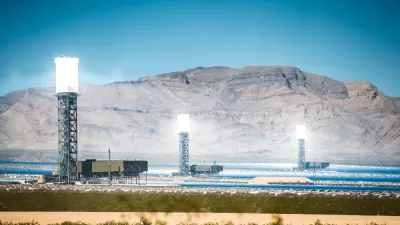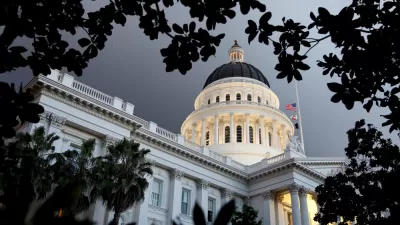While California cap-and-trade survived a legal challenge last month, a haze still surrounds the program. Carbon permit sales are low, and the program's longevity is threatened after 2020. A new bill was introduced to transform the program.
On April 6, a California court of appeals ruled in favor of the California Air Resources Board (CARB or ARB), the agency administering the nation's only state-run carbon trading program, though appellant Pacific Legal Foundation has indicated it will appeal to the California Supreme Court, claiming the carbon permits that emitters are required to purchase are in essence taxes.
The cap-and-trade program was authorized by AB 32, the Global Warming Solutions Act of 2006, which mandates carbon reductions to the year 2020. While SB 32, approved last year, extends CARB's authorization to reduce carbon emissions to 2030, it doesn't mention cap-and-trade.
With the introduction of SB 775 on May 1 by Senator Bob Wieckowski (D-Fremont), chair of the Senate Environmental Quality Committee, and Senate President pro Tempore Kevin de León, there are now three bills providing for the extension of cap-and-trade beyond 2020, according to a background document (pdf) prepared for the May 10 oversight hearing at the Senate Environmental Quality Committee. The other two are AB 151 and AB 378.
David Roberts, energy and climate change writer for Vox, reports that "the changes that SB 775 proposes for the state’s carbon trading program are dramatic — and, to my eyes, amazingly thoughtful."
I know some environmental groups have reservations, but in my opinion, if it passes in anything close to its current form, it will represent the most important advance in carbon-pricing policy in the US in a decade. Maybe ever.
The bill establishes three programs where revenue from carbon allowance sales would be directed:
- "The first and largest is the California Climate Dividend Program, which will rebate revenue on a per-capita basis. The bill also establishes a Climate Dividend Access Board (CDAB) that will work with low-income and immigration groups to make sure the dividends reach everyone, even in vulnerable communities.
- "The second bucket is for 'public infrastructure investments and investments in disadvantaged communities.'(Vulnerable communities receive roughly 40 percent of current carbon revenue.)
- "The third is for 'climate and clean energy research and development.'”
According to James Temple, senior editor for energy at MIT Technology Review, "[a]round 90 percent of the revenue from the program, which would raise several billion dollars annually and climb steadily over time, would go back to California citizens in the form of a "climate dividend rebate."
Two other noteworthy aspects of the legislation deal with carbon prices and elimination of controversial "carbon offsets, which allow companies to emit more carbon dioxide if they invest in green projects elsewhere, such as a tree-planting carbon sequestration scheme," adds Temple.
Properly accounting for the benefits and costs of such programs has proven challenging, and critics argue it's far more effective to directly incentivize companies to reduce their own pollution.
As for prices, the bill sets both a floor and a ceiling, a so-called "collar", and the price range would make it one of the highest in the world in time, reports Temple.
The price collar would start at $20 and $30 in 2021, rise to $20 and $40 in 2022, and then tick up each subsequent year by $5 and $10, respectively, plus inflation adjustments.
The ceiling would immediately be higher than the price of carbon in most European nations, and would quickly exceed the roughly $37 tax proposed in Canada starting in 2022. [Also see Planetizen on "Deciding the Price of Canada's Carbon"].
Environmentalist objections
Erica Morehouse of the Environmental Defense Funds argues that "California’s cap-and-trade program doesn't need an overhaul."
Rather than scrapping the current system and starting over with an unproven approach, the state should build on success, keeping what is working well while strengthening the program by doing more to address local air pollution and environmental justice.
Support from environmental justice groups
The California Climate Equity Coalition, led by The Greenlining Institute, the Asian Pacific Environmental Network, Public Advocates, Coalition for Clean Air and SCOPE was "encouraged by the ambitious direction of SB 775 (Wieckowski) that will put a higher price on carbon, more effectively reduce greenhouse gas pollution, and create more market certainty," according to their press release.
CCEC believes policies addressing climate change must prioritize the communities hit first and worst by pollution, poverty and climate change. We hope that SB 775 will create stability in revenues for investments that benefit underserved communities and households
Two-thirds supermajority needed
Like the bill last month that hiked gas taxes 12 cents per-gallon, proponents hope to pass SB 775 with a two-thirds supermajority to avoid the litigation that plagued the current program, beginning with its first carbon credit auction. Gov. Jerry Brown expressed optimism that a deal could be reached this year, according to E&E News reporter, Debra Kahn.
"I'll tell you why we have a very good chance. The money that comes from cap and trade, 50 percent of it benefits disadvantaged communities.
The bill's author, Sen. Bob Wieckowski, summed-up the essence of his bill in his statement to the Senate Environmental Quality Committee at its oversight hearing on May 10:
We need to implement a price collar to prevent the cost of carbon from skyrocketing, gradually increase the price to reduce emissions and spark innovation, and give back a climate dividend to California residents.
These components, along with a two-thirds vote to reduce the threat of a Prop. 26 legal challenge, are all key components of SB 775.”
FULL STORY: California is about to revolutionize climate policy … again

Maui's Vacation Rental Debate Turns Ugly
Verbal attacks, misinformation campaigns and fistfights plague a high-stakes debate to convert thousands of vacation rentals into long-term housing.

Planetizen Federal Action Tracker
A weekly monitor of how Trump’s orders and actions are impacting planners and planning in America.

San Francisco Suspends Traffic Calming Amidst Record Deaths
Citing “a challenging fiscal landscape,” the city will cease the program on the heels of 42 traffic deaths, including 24 pedestrians.

Adaptive Reuse Will Create Housing in a Suburban Texas Strip Mall
A developer is reimagining a strip mall property as a mixed-use complex with housing and retail.

Study: Anti-Homelessness Laws Don’t Work
Research shows that punitive measures that criminalized unhoused people don’t help reduce homelessness.

In U.S., Urban Gondolas Face Uphill Battle
Cities in Latin America and Europe have embraced aerial transitways — AKA gondolas — as sustainable, convenient urban transport, especially in tricky geographies. American cities have yet to catch up.
Urban Design for Planners 1: Software Tools
This six-course series explores essential urban design concepts using open source software and equips planners with the tools they need to participate fully in the urban design process.
Planning for Universal Design
Learn the tools for implementing Universal Design in planning regulations.
Heyer Gruel & Associates PA
JM Goldson LLC
Custer County Colorado
City of Camden Redevelopment Agency
City of Astoria
Transportation Research & Education Center (TREC) at Portland State University
Jefferson Parish Government
Camden Redevelopment Agency
City of Claremont




























